
Concept explainers
Interpretation:
Structures corresponding to the peaks should be explained.
Concept introduction:
Mass spectrometry is an important spectroscopic method to determine the molecular weights and molecular formulas of the compounds. It also can help in the identification of compound or determination of its structure.
A mass spectrograph is plotted between the intensity of ions on the y-axis and m/z on the x-axis.
Mass spectrometry is performed as follows:
- A sample is converted into a gaseous ion by an ionization technique in the mass spectrometer.
- Then on the basis of mass-to-charge m/z ratios, gaseous ions are arranged.
- And these ions when generate electricity a mass spectrum is formed.
To assign the molecular weights to compounds the rule of thirteen is used in mass spectrometry. Thirteen here is obtained by adding the mass of carbon and hydrogen.
If the molecular ion peak is intense then M+1 and M+2 the peak will also be observed. And the ratio of intensities of M+1 and M+2 predict the presence of halogen isotopes.
If the ratio of M+1 and M+2 peak is 1:1 then bromine isotopes are present in the mixture and if 1:3 is the intensity ratio then the presence of chloride isotope is confirmed.
The peak intensity ratio depends on the abundance of isotopes in nature.
Want to see the full answer?
Check out a sample textbook solution
Chapter 24 Solutions
Laboratory Techniques in Organic Chemistry
- We mix N-ethyl-2-hexanamine with excess methyl iodide and followed by heating with aqueous Ag2O. Indicate the major products obtained.arrow_forwardIndicate the products obtained by mixing acetophenone with iodine and NaOH.arrow_forwardIndicate the products obtained by mixing 2-Propanone and ethyllithium and performing a subsequent acid hydrolysis.arrow_forward
- Indicate the products obtained if (E)-2-butenal and 3-oxo-butanenitrile are mixed with sodium ethoxide in ethanol.arrow_forwardQuestion 3 (4 points), Draw a full arrow-pushing mechanism for the following reaction Please draw all structures clearly. Note that this intramolecular cyclization is analogous to the mechanism for halohydrin formation. COH Br + HBr Brarrow_forwardIndicate the products obtained if 2,2-dimethylpropanal and acetaldehyde are mixed with sodium ethoxide in ethanol.arrow_forward
- Indicate the products obtained if 2,2-dimethylpropanal and acetaldehyde are reacted with sodium ethoxide in ethanol.arrow_forward2,2-Dimethylpropanal and acetaldehyde are reacted with sodium ethoxide in ethanol. Indicate the products obtained.arrow_forwardAdd conditions above and below the arrow that turn the reactant below into the product below in a single transformationADS fint anditions 百 Abl res condinese NC ง Add on condtions 1.0 B H,N.arrow_forward
 Organic ChemistryChemistryISBN:9781305580350Author:William H. Brown, Brent L. Iverson, Eric Anslyn, Christopher S. FootePublisher:Cengage Learning
Organic ChemistryChemistryISBN:9781305580350Author:William H. Brown, Brent L. Iverson, Eric Anslyn, Christopher S. FootePublisher:Cengage Learning Principles of Instrumental AnalysisChemistryISBN:9781305577213Author:Douglas A. Skoog, F. James Holler, Stanley R. CrouchPublisher:Cengage Learning
Principles of Instrumental AnalysisChemistryISBN:9781305577213Author:Douglas A. Skoog, F. James Holler, Stanley R. CrouchPublisher:Cengage Learning

